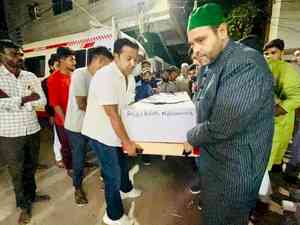Heading to Shimla? Water crisis will distress you
Shimla, June 18 (IANS) Planning to head to the Queen of Hills, as Shimla was called by the British, to beat the heat? Think twice. You might get much relief from the scorching heat of the plains, but the water shortage here will leave you high...

Shimla, June 18 (IANS) Planning to head to the Queen of Hills, as Shimla was called by the British, to beat the heat? Think twice. You might get much relief from the scorching heat of the plains, but the water shortage here will leave you high and dry - literally!
"Where is the excitement for cool hills coated with Himalayan cedars when it's woes instead of water that is flowing out of the taps," remarked Aditya Kant, a tourist from Delhi, to IANS.
He said he was charged Rs.50 for an extra bucket of water provided to him by his hotel.
"I have travelled across the country, but never seen the tourists left to fend for themselves," Adiyta Kant added.
Locals blame the successive governments that have failed to mitigate the problem of water shortage, which is more or less low round the year.
"These days we are getting water supply once in two or three days, that too only in the morning for just two hours," remarked M.R. Kaundal, a retired government employee who has been long settled in Shimla.
He said the water supply was normal till the 1990s.
But the local civic authorities blame leakages in the distribution network, a significant portion of which goes back to the British days, and diminishing water resources that have been over-exploited to meet the increasing demand for the tourism industry.
"The floating population of tourists is also making the situation worse for the locals," Shimla Mayor Sanjay Chauhan told IANS.
He said most of the water supply lines are prone to leakages that cause huge losses.
"Plugging of leaks can help save a substantial quantity of water and also ensure quality. We have also ordered disconnection of water supply in case there is a leakage in overhead tanks of commercial and residential users," Chauhan added.
Official sources said the town was planned by the British India for a maximum population of 16,000. It now supports more than 200,000.
According to the tourism industry representatives, Shimla gets 20,000 to 30,000 tourists on an average on every weekend during the peak tourism season - May to June-end and December-January.
Shimla's normal demand of water is 42 million litres per day (MLD) but the availability ranged from 35 to 37 MLD, the irrigation and public health department said.
During the peak tourist season, the demand-supply gap, which is normally five to seven MLD, increases to 17 MLD.
Irrigation and Public Health Minister Vidya Stokes attributed the water shortage to frequent electricity failures, water distribution losses of around 26 percent and lesser storage capacity with the civic body.
"We are seeking funds from the World Bank to construct a gravity drinking water supply scheme from Pabbar river (near Rohru town) to Shimla," she said, adding this would meet Shimla's water requirement till 2037.
The previous state government had mooted a proposal to lift the water of the Satluj river from the Kol Dam near Tatapani to overcome Shimla's water shortage in Shimla.
Official sources said the Pabbar river project is not economically viable as it is three times expensive than the Satluj one.
(Vishal Gulati can be contacted at [email protected])

 cityairnews
cityairnews 














